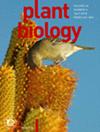Multimodal floral cues resembling both generalized food sources and oviposition sites in Isotrema manshuriense (Aristolochiaceae) pollinated by flies
IF 3.6
3区 生物学
Q1 PLANT SCIENCES
引用次数: 0
Abstract

苍蝇传粉的马兜铃属植物中类似于一般食物来源和产卵地点的多模式花线索。
马兜铃属植物以其壶状的诱捕花而闻名,这些花主要利用诱捕毛暂时留住来访的昆虫。大多数马兜铃属植物通过模仿其产卵地点和/或食物来源来吸引苍蝇传粉者。在这项研究中,我们研究了Isotrema manshuriense的潜在模仿系统,Isotrema manshuriense以前被归类为马兜铃(Aristolochia manshuriensis),缺乏捕获毛。我们确定了它的传粉者,并分析了它的多模式花线索。花期分为雌性期、间期和雄性期三个性征期。收集并鉴定了被困在花中的昆虫。利用气相色谱-质谱分析了雌花的肢体分泌物代谢谱。通过测量花空间部分的光谱反射率,研究了雌花和雄花的视觉和嗅觉线索。在白天和晚上分别分析了花的外部和内部挥发性化合物。通过非度量的多维尺度比较了其他物种和潜在模型的花香特征。访花蝇以雌蝇居多,传粉昆虫为粉蝇科、花蝇科和花蝇科。雌花和雄花的滞留昆虫数量无显著差异。肢体分泌物中含有多种氨基酸和有机酸。花被颜色的时空变化,包括紫外线反射率和花香成分。值得注意的是,外部的花香类似于葫芦果的花香,而内部的香味更类似于报偿花的花香。manshuuriense具有独特的花性状,不同于其他类似于育苗地点的Isotrema和马兜铃属植物,同时具有传粉者的腐食性。这表明manshuriense整合了多种模式,将花定位为一般食物来源和产卵地点之间的表型中间物。
本文章由计算机程序翻译,如有差异,请以英文原文为准。
求助全文
约1分钟内获得全文
求助全文
来源期刊

Plant Biology
生物-植物科学
CiteScore
8.20
自引率
2.60%
发文量
109
审稿时长
3 months
期刊介绍:
Plant Biology is an international journal of broad scope bringing together the different subdisciplines, such as physiology, molecular biology, cell biology, development, genetics, systematics, ecology, evolution, ecophysiology, plant-microbe interactions, and mycology.
Plant Biology publishes original problem-oriented full-length research papers, short research papers, and review articles. Discussion of hot topics and provocative opinion articles are published under the heading Acute Views. From a multidisciplinary perspective, Plant Biology will provide a platform for publication, information and debate, encompassing all areas which fall within the scope of plant science.
 求助内容:
求助内容: 应助结果提醒方式:
应助结果提醒方式:


